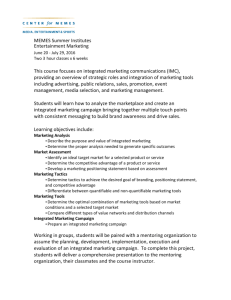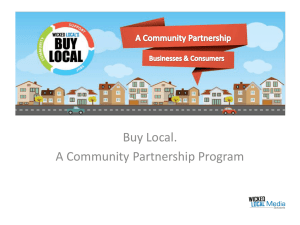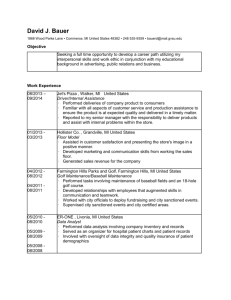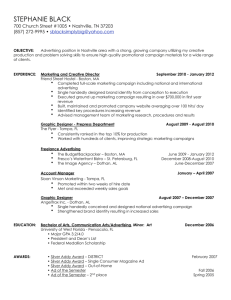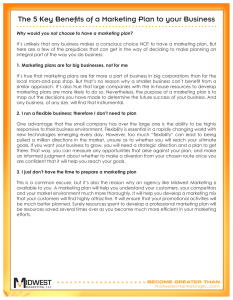complete IMC report
advertisement
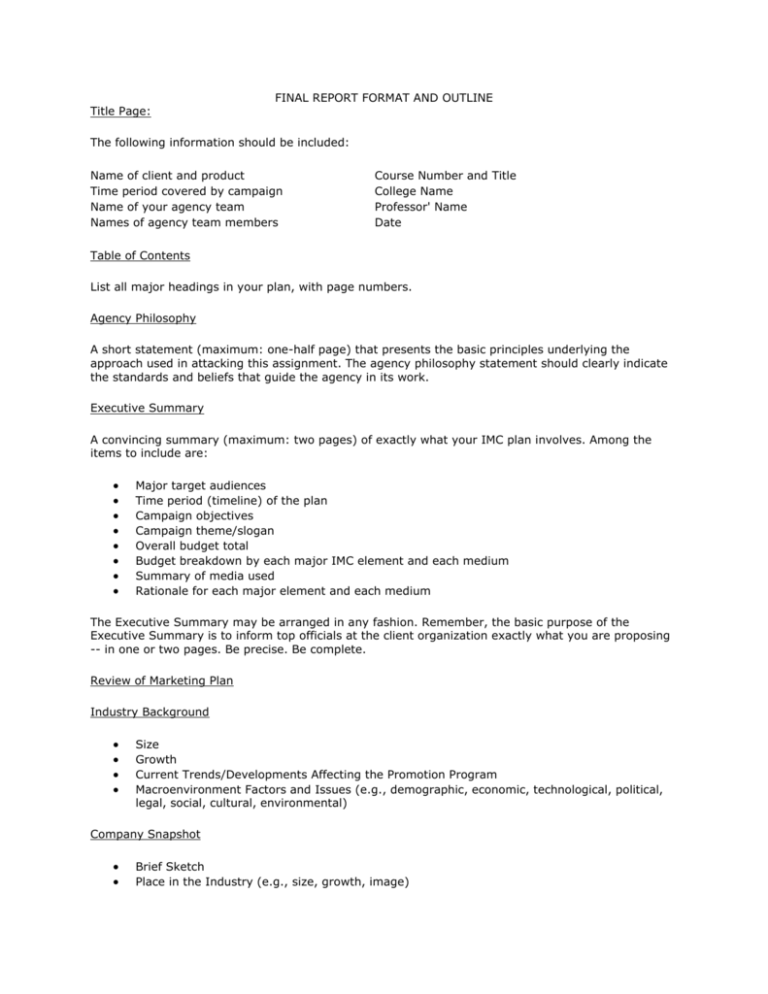
FINAL REPORT FORMAT AND OUTLINE Title Page: The following information should be included: Name of client and product Time period covered by campaign Name of your agency team Names of agency team members Course Number and Title College Name Professor' Name Date Table of Contents List all major headings in your plan, with page numbers. Agency Philosophy A short statement (maximum: one-half page) that presents the basic principles underlying the approach used in attacking this assignment. The agency philosophy statement should clearly indicate the standards and beliefs that guide the agency in its work. Executive Summary A convincing summary (maximum: two pages) of exactly what your IMC plan involves. Among the items to include are: Major target audiences Time period (timeline) of the plan Campaign objectives Campaign theme/slogan Overall budget total Budget breakdown by each major IMC element and each medium Summary of media used Rationale for each major element and each medium The Executive Summary may be arranged in any fashion. Remember, the basic purpose of the Executive Summary is to inform top officials at the client organization exactly what you are proposing -- in one or two pages. Be precise. Be complete. Review of Marketing Plan Industry Background Size Growth Current Trends/Developments Affecting the Promotion Program Macroenvironment Factors and Issues (e.g., demographic, economic, technological, political, legal, social, cultural, environmental) Company Snapshot Brief Sketch Place in the Industry (e.g., size, growth, image) Mission, Business Philosophy Resources Organizational Structure Product Line Sales History Target Markets Market Shares Positioning Current Marketing Mix Product/Service Review Category Review Description o Life Cycle Stage o Sales, Growth Brand Review (the product/service that constitutes the focus of the campaign) Description o Market Share, Sales, Growth o Strengths and Weaknesses o Key Benefits o Brand Image o Positioning Product/Brand Performance in Selected Markets Competitive Review Direct and Indirect Competitors Key Competitors (each considered separately) Market Shares, Sales, Growth Target Markets Marketing Objectives Marketing Strategies Positioning Budgets Current Marketing Mixes/Tactics Current Advertising, Sales Promotion, Public Relations, and Direct Marketing Programs Message Strategies Media Strategies Strengths Weaknesses Overall Assessment Buyer Analysis User Profile (demographic, geographic, psychographic, behavioristic factors) Buying Decision Process Who Buys the Product Who Influences the Purchase Decision Who Makes the Decision Decision Criteria Strengths and Weaknesses (e.g., Crackerjack Golf Club Company -- new line of golf clubs) Strengths Crackerjack is known for innovative products Strong base in professional golf shops Highest consumer satisfaction ratings among major brands Outstanding sales force Weaknesses Highest prices in the industry Advertising expenditures are less than half those of major competitors Little trade promotion Weak presence in mass-merchandise and discount stores Threats and Opportunities (e.g., Crackerjack Golf) Threats Increasing number of golfers are buying equipment in mass-merchandise and discount stores Crackerjack's most-feared rival, Nifty Golf, recently introduced its entire line into a major golf discount chain Several major competitors have become more aggressive in trade promotion efforts Opportunities More people of all ages are playing golf A major sporting goods chain indicated it would carry Crackerjack irons, if Crackerjack would increase its trade allowances and introduce a cooperative advertising program Some notable professional golfers have recently switched to Crackerjack irons, with positive results Marketing Goals Marketing goals are what is to be accomplished by the overall marketing program. The situation analysis is the foundation for the marketing goals. They are defined in terms of one or some combination of the following: Sales Volume Market Share Sales Revenue Profit Return on Investment Marketing goals and communications objectives are not the same. Marketing goals establish a framework for the determination of communications objectives. Target Market Segmentation Analysis Primary Target Market Secondary Target Market Promotional Program Situation Analysis Review of Existing/Past Programs - Detailed Review of Previous and Current Promotion Programs for the Product or Service, including Budgets, Promotion Mix, Share of Voice, Message Strategies, and Media Strategies o Strengths o Weaknesses o Overall Assessment IMC Objectives and Strategies (i.e., what needs to be accomplished in order for Crackerjack to meet marketing goals and how the objectives will be achieved) A statement of what the marketing communications program will accomplish - the role the program will play in the marketing effort. IMC objectives involve a desired audience response, which results from the process of consumer decision making, useful frameworks for planners are the hierarchy-ofeffects models discussed in Chapter 6 of the text (p. 173). Example Objectives: Awareness Objectives: used when most of the target audience is unaware of the product, service or brand or when awareness levels need to be increased Knowledge Objectives: used when the target audience has awareness, but knows little beyond that Liking Objectives: used when the target audience knows the company and its product, but does not look favorably on it Preference Objectives: used when the target audience is aware of the product, knows about it, and likes it - but does not prefer it to other brands Conviction Objectives: used when the target audience may prefer the product but is not convinced that it is the best choice for them Purchase (i.e., Action) Objectives: used when the target audience has conviction but still hasn't purchased the product Campaign Objectives - Example (e.g., Crackerjack Golf) increase awareness among golfers by 10% that Crackerjack irons have the highest consumer satisfaction ratings of all major brands, in a three-month time period increase trial of Crackerjack irons among golfers 35-49 by 3% in three-month time period create the understanding among 5% of target audience that Crackerjack's Big Blaster driver allows the golfer to hit the ball farther with greater accuracy Campaign Strategies (e.g., Crackerjack Golf) place advertising in special interest golf magazines provide cooperative advertising support to retail outlets make available demonstration sets to key retailers to stimulate trial sponsor instructional clinics for golfers of all ages Follow each objective and strategy with a brief rationale. Positioning and Campaign Theme (i.e., the image you want your product to have in the minds of the target market; how you want your product perceived relative to the competition; it is the basis for all your communications) 1. Positioning Strategy (e.g., by product difference, by key attribute or benefit, by usage, against a specific competitor(s), by users of the product) 2. Positioning Statement 3. Campaign Theme (i.e., the slogan) Creative Recommendations Target Audience The Copy Platform (which includes the following) Advertising Objectives (what the advertising is supposed to do) o Example: To increase awareness ... o Example: To persuade the target audience that ... Advertising Strategy (what the advertising is attempting to communicate; i.e., the benefit, problem solution or other advantage that is the value of the product -- physical or psychological) Example: Use of this product will allow you to recover more quickly after strenuous exercise. Advertising Appeals (how the advertising stimulates interest and influences feelings) Example: fear, pleasure, comfort, convenience Advertising Execution Format (how the advertising appears) Example: demonstration, problem-solution, comparison Media selection Executions (message strategy) Storyboards, Scripts, Mechanicals, etc. Advertising Media Recommendations Target Audience Objectives Example: To achieve an 80 reach and a frequency level of three Example: To increase advertising in geographical areas where BDI is not at pace with CDI. Strategy Example: Use magazines primarily targeted toward women 25-49. Example: Schedule increased media use to coincide with sales promotions. Example: Increase radio advertising in selected markets. The Media Plan Rationale Budget Sales Promotions Recommendations (Consumer) Target Audience Objectives Techniques Sales Promotion Plan/Timing Rationale Budget Sales Promotions Recommendations (Trade) Target Audience Objectives Techniques Sales Promotion Plan/Timing Rationale Budget Direct Marketing Recommendations Target Audience Objectives MediaType Direct Mail Electronic Print Media Telemarketing Catalog Kiosk Face-to-Face Selling Direct Marketing Plan/Timing Rationale Budget Internet/Interactive Recommendations Target Audience Objectives Strategies/executions Rationale Budget Public Relations Recommendations (including press releases, press conferences, special events, sponsorships, product placements, and cause-related efforts) Target Audience Objectives Strategy/Execution Scheduling/Plan Rationale Budget Personal Selling Recommendations Target Audience Objectives Strategy Rationale Budget Campaign Flowchart A one-page summary diagram showing the timing of the major elements, events, and activities of the campaign. The campaign flowchart shows at a glance what is to happen when throughout the entire campaign. Measurement and Evaluation Measurement and evaluation activities occur during the course of the campaign, as well as at the end. This section of the proposal should contain a description of those activities and the specific methods that will be used to appraise the individual components of the campaign, as well as for measuring the overall effectiveness of the campaign. Budget Summary This section is a summary of all costs of the campaign (e.g., media, production, sales promotion, direct marketing, public relations, sponsorship, endorsements, measurement and evaluation expenditures, and more). The budget should show both dollar and percent-of-total expenditures. Timetable Summary of key dates for various activities (e.g., date for client approval of creative strategy, dates for production materials, dates for tracking studies). Conclusion A very brief review of your plan and how well it meets the needs of the client. One page should be sufficient to summarize the factors that make your plan the one that will best get the job done for the client. Recommendations for the future. Appendices In most cases, this is a very important section of the plan. It will include information and material which have potential value to your client and which have not been fully presented in the text of your plan. Examples: industry data, market data, questionnaires, competitors' advertisements. This section can be a valuable resource for your client. References A complete list of secondary sources used for the campaign plan.


